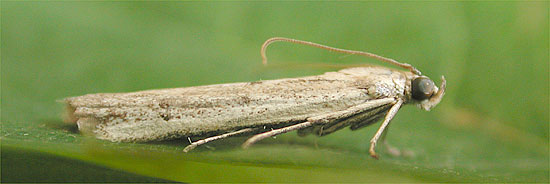Pests
Homoeosoma nebulellum Den. et Schiff. - Sunflower Moth.
Systematic position.
Class Insecta, order Lepidoptera, family Pyralidae, genus Homoeosoma.Synonym.
H. nebulella Hbn.Biological group.
Oligophagous pest of Asteraceae. Main pest of sunflower in the past and a potentially very dangerous one in the future.Morphology and biology.
Wingspan 18-27 mm in adult, fore wings are narrow, gray with 3-5 dark spots in the middle, hind wings are wider and lighter, with dark veins. Larva 9-18 mm in length, yellow-green, with brown-red bands on body, and with umber head and scutum. Pupa 9-13 mm, brown. Females lay their eggs in inflorescence of asteraceous plants. Fecundity is about 100-300 eggs, maximum 400; eggs are laid one by one or in small batches. Embryonic development lasts 3 to 7 days. After eclosion larvae feed on pollen and petals of flowers; but beginning from 3rd instar, they put teeth into pulp of inflorescence, where they burrow tunnels within parenchyma, eat up lower parts of flowers and contents of seeds. The larval stage lasts 13 to 20 days. After completion of feeding the larva usually goes down into earth, where it spins a cocoon at the depth of a few centimeters for pupation or overwintering. Development of pupa lasts about 17 days.Distribution.
Rather widespread, everywhere in Western Europe including the south of Scandinavia and Great Britain, North Africa, Asia Minor, and the Middle East. Closely related species H. electellum inhabits North America, being widespread. In the former USSR the northern border of distribution passes from the Gulf of Finland to the Ladoga Lake, then along the left bank of Volga and from Samara to Orenburg towards the mouth of Syr Darya river. It is widely distributed in Middle Asia, Kazakhstan, Siberia, and the Far East (Amur Region, Primorskii Territory). Pest inhabits all regions where sunflower is cultivated.Ecology.
Polyvoltine species. Depending on latitude and on presence of suitable host plants can develop in 1 to 4 generations, and even a fifth incomplete generation may occur. In central Russia 2 generations usually develop with the second one being possibly incomplete. Adults appear usually at the end of May or in June. Many species of Asteraceae are used as host-plants in addition to sunflower, e.g. safflower, aster, chrysanthemum, marigolds, camomile, thistle, groundsel, tansy, cornflower, etc. Larval feeding occurs on reproductive organs of plants exclusively, and damaged stems have not been recorded. Hibernation of mature larvae and their pupation takes place inside cocoons within the surface layer of soil. Factors of plant resistance play the primary role in reduction of pest development, in particular, phytomelanin contained in pericarp of sunflower achenes. Natural biological agents also influence population dynamics of the pest, specifically fungus Metarrhizum anisopliae and a number of parasitic insect species of Hymenoptera and Diptera.Economic significance.
Originally sunflower moth was associated with wild Asteraceae only, but after sunflower introduction into culture it quickly shifted to feeding on the crop. By the end of the 19th century the Sunflower Moth became the primary pest of the crop, causing 20-60% losses. Harm of the Sunflower Moth is caused by direct eating of achenes, and also by covering baskets with web and by contamination with excrements; the baskets often rot after rain-water penetration into larval tunnels. Presently the harm to the sunflower is very insignificant in connection with introduction of "testaceous" varieties, which are rarely damaged due to presence of protective layer in pericarp of achenes. The pest continues to be rather dangerous to safflower, aster and some other garden Asteraceae. Control measures include the growing of "testaceous" varieties of sunflower; deep plowing after sunflower harvest is also useful.Related references:
Anonym. 1997. Homoeosoma nebulella (Denis & Schiffermueller). Sunflower moth. Description, Biology, Life Cycle, Damage, Common Names, Images. http://www.inra.fr/Internet/Produits/HYPPZ/RAVAGEUR/6homneb.htmAnonym. 2001. The North Central Regional Plant Introduction Station. The sunflower moth. http://www.ars-grin.gov/ars/MidWest/Ames/Entomology/Sunflower%20Moth.html .
Korol.kov, D.M., 1922. Sunflower snow-storm or sunflower moth (Homoeosoma nebulella). In: Proc. 4th All-Russian Entomol.-Phytopathol. conf., Moscow, 8-14 Dec. 1922. Leningrad: 1924, p. 1-40 (in Russian).
Kuznetsov, V.I., ed. 1999. Insects and mites - pests of agricultural plants. V. 3(2). Lepidoptera. St.Petersburg: Nauka, 407 p. (in Russian).
Reymonet, C. 1991. Qui a peur de la pyrale du tournesol? Contribution à l'étude, dans le Lauragais, du cycle biologique d'un ravageur potentiel du tournesol, Homoeosoma nebulella (Denis et Schiffermüller). Thèse doct. Ecol. expér., Univ. de Pau et des Pays de l'Adour. 127 pp.
Rogers, C.E., Kreitner, G.L. 1983. Phytomelanin of sunflower achenes: and mechanism for pericarp resistance to abrasion by larvae of the sunflower moth (Lepidoptera: Pyralidae). Environ. Entomol. 12(2), p. 277-285.
Shchegolev, V.N., Znamenskii, A.V. & Bei-Bienko, G.Ya. 1934. Insect pests on field crops. Leningrad & Moscow: Sel.khozgiz, 364 p. (in Russian).
Vasil.ev, V.P. ed., 1973. The pests of agricultural crops and forest plantations. V. 2. Kiev: Urozhai. 606 p. (in Russian).


